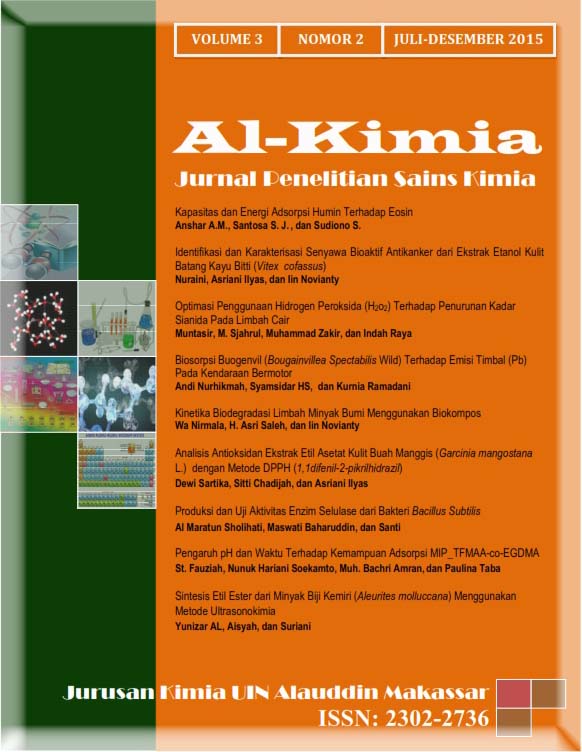Analisis Antioksidan Ekstrak Etil Asetat Kulit Buah Manggis (Garcinia mangostana L.) Dengan Metode Dpph (1,1difenil-2-pikrilhidrazil)
Abstract
Mangosteen fruit (Garcinia mangostana L.) is a potential source of natural antioxidant. This research can be seen through comparison of the effect of the solvent ethyl acetate for extract mangosteen rind (garcinia mangostana L.) the optimal antioxidant substances for withdrawal. Method used is maceration extraction using methanol and liquid phase using three variable 1:3, 1:4 and 1:5. The test Includes a qualitative and quantitative test of antioxidant. The results of the qualitative test show the presence of antioxidant in the yellow extract of mangosteen rind which turn purple discoloration on color test and the emergence of patches of yellow with purple backgroud on TLC when sprayed solution of DPPH 40 ppm. Then quatitativ test retrieved % high curbs in comparison 1:3.Downloads
References
Gupita, C. N., dan Rahayuni, A., 2012, Pengaruh Berbagai Ph Sari Buah Dan Suhu Pasteurisasi Terhadap Aktivitas Antioksidan Dan Tingkat Penerimaan Sari Kulit Buah Manggis, 1 (1).
Miksusanti, E., dan S. Hotdelina, 2012, Aktivitas Antioksidan dan Sifat Kestabilan Warna Campuran Ekstrak Etil Asetat Kulit Buah Manggis (Garcinia Mangostana L.) dan Kayu Secang (Caesalpinia Sappan L.). 15 (2).
Jessica, O. S.,. 2013. “Daya Antioksidan Ekstrak Etanol Kulit Buah Manggis (Garcinia Mangostana L) Hasil Pengadukan dan Reflukx”. 2 (1).
Setyaningrum, E. N., 2010. Efektivitas Penggunaan Jenis Asam Dalam Proses Ekstraksi Pigmen Antosianin Kulit Manggis (Garcinia Mangostana L) Dengan Penambahan Aseton 60%, Skripsi Sarjana Fakultas Pertanian Universitas Sebelas Maret: Surakarta.
Supiyanti, W. D., dkk., 2010, Test Of Antioxidant Activity And Determination Of Total Antyhocyanin Content Inrind Of Mangosteen (Garcinia Mangostana L), 15 (2).
Stevi G, dkk, 2012, Aktivitas Antioksidan Ekstrak Fenolik Dari Kulit Buah Manggis (Garcinia Mangostana L.), Jurnal Kimia, 1 (1).
Authors who publish with this journal agree to the following terms:
1) Authors retain copyright and grant the journal right of first publication with the work simultaneously licensed under a Creative Commons Attribution License that allows others to share the work with an acknowledgement of the work's authorship and initial publication in this journal.
2) Authors are able to enter into separate, additional contractual arrangements for the non-exclusive distribution of the journal's published version of the work (e.g., post it to an institutional repository or publish it in a book), with an acknowledgement of its initial publication in this journal.
3)Authors are permitted and encouraged to post their work online (e.g., in institutional repositories or on their website) prior to and during the submission process, as it can lead to productive exchanges, as well as earlier and greater citation of published work (See The Effect of Open Access).


